During a soul-searching trip to Ilocos, I discovered Dinakdakan, a dish that would forever change my perspective on Filipino cooking.
It was in a humble kitchen in Vigan where I first watched a local transform simple pork parts into this mouthwatering delicacy. The sizzle of the grilled meat, the bright punch of calamansi, and that signature creamy sauce created a symphony of flavors I had never experienced before.
Like many Filipinos, I was initially hesitant about some of the ingredients (yes, I'm looking at you, pig brain), but one bite was all it took to convert me into a lifelong fan.
This authentic Ilocano dinakdakan recipe has been tested and perfected in my own kitchen countless times, and I'm excited to share it with you today.
This recipe captures the authentic flavors of the North while being approachable enough for any home cook to master.
What is Warek-Warek?
Warek-warek is the traditional Ilocano name for Dinakdakan. "Warek" in Ilocano means "to scatter" or "to mix vigorously." The name is doubled (warek-warek) to emphasize the action, referring to the vigorous mixing or tossing of the chopped grilled meat with its ingredients. This name perfectly captures the final step in preparing Dinakdakan, where all the components - the grilled pork parts, brain or mayonnaise, calamansi juice, onions, ginger, and chilies - are thoroughly tossed together until well combined.
The term has deep cultural significance in Ilocano cuisine, as it represents not just the physical action of mixing but also the bringing together of different textures and flavors that make the dish unique. Some Ilocano elders say the name also comes from the sound ("warek-warek") made when mixing the ingredients together in a large bowl or when chopping the meat on a wooden cutting board.
Interestingly, while Dinakdakan has become the more widely known name across the Philippines, many traditional Ilocano households and establishments still prefer to call it warek-warek, maintaining its authentic linguistic and cultural roots.
Jump to:
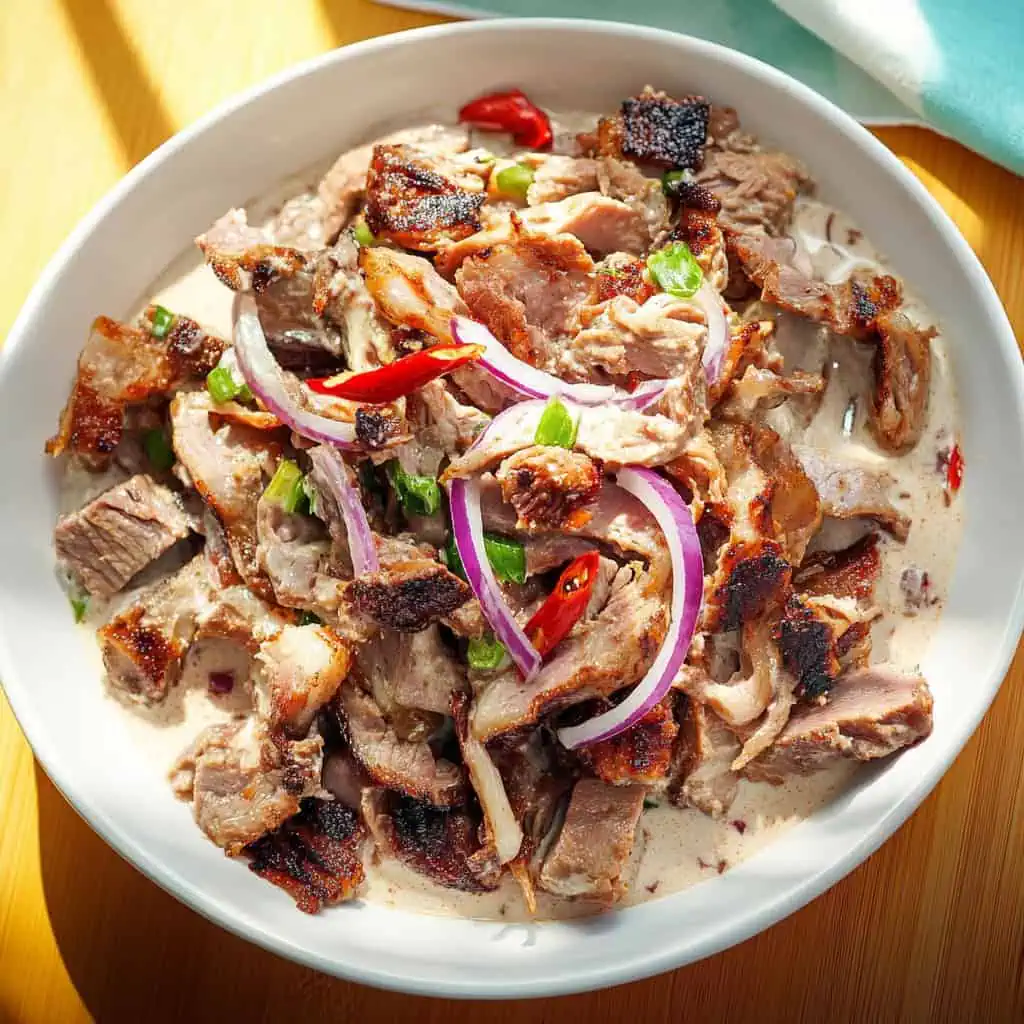
Why You'll Love This Recipe
- Authentic Ilocano flavors passed down through generations
- Perfect balance of creamy, tangy, and spicy notes
- Great use of sustainable nose-to-tail cooking
- Versatile as both pulutan (bar food) or ulam (main dish)
- Complex textures from different pork parts
- Can be customized to your heat preference
Ingredients
This authentic Ilocano Dinakdakan combines specific ingredients that create a perfect harmony of flavors and textures. The pork face, ears, and liver provide different textural elements while showcasing traditional nose-to-tail cooking.
Pig brain (or mayonnaise as a substitute) creates the essential creamy base that coats every piece of meat. Aromatics like red onion, ginger, and Thai chilies add layers of sharpness, warmth, and heat. Calamansi juice brings necessary acidity that cuts through the richness, while bay leaves and peppercorns in the boiling liquid infuse the meat with depth.
Together, these ingredients create the signature smoky-tangy-creamy-spicy profile that makes Dinakdakan a beloved Ilocano delicacy that perfectly balances bold flavors while honoring culinary traditions.
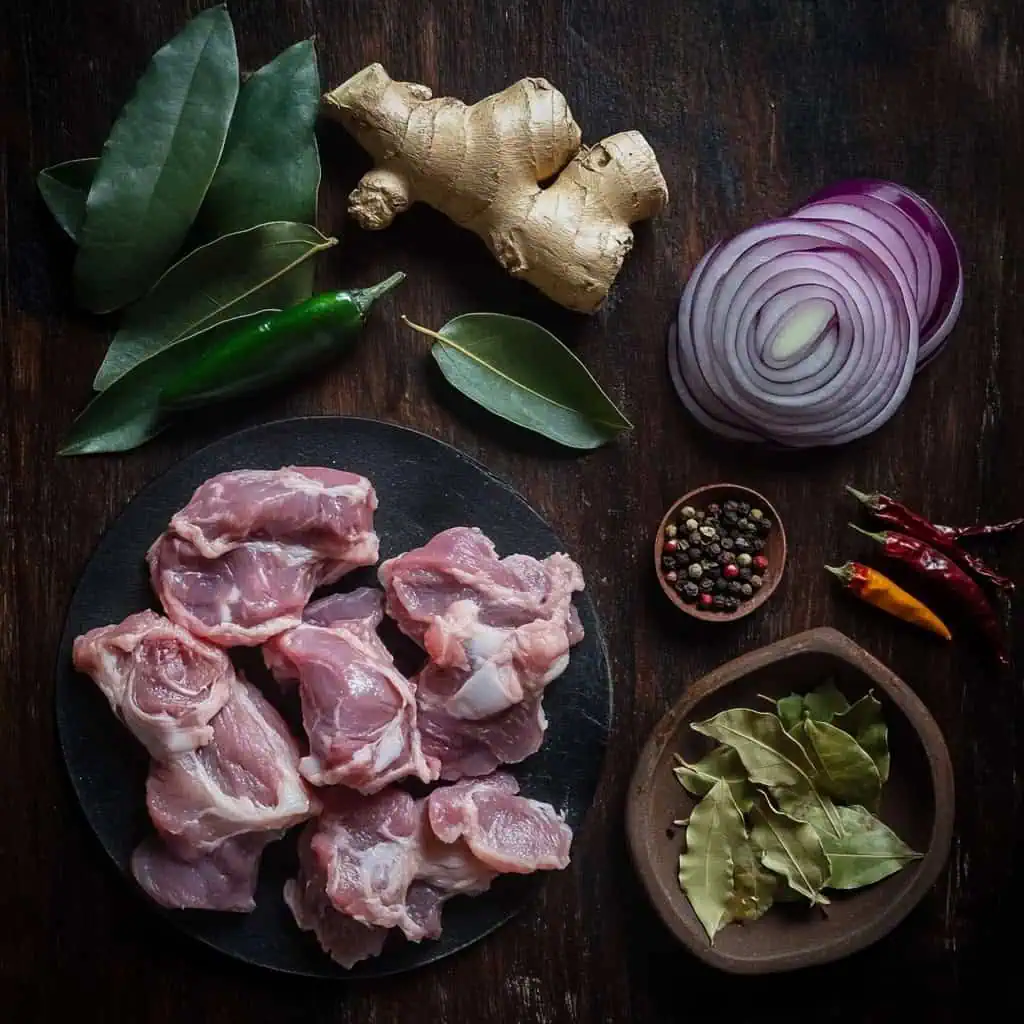
For the Meat Base:
- 2 pounds pork face/snout and ears
- ½ pound pork liver
- 8 ounces pig brain
- Water for boiling
For the Aromatics:
- 2 bay leaves
- 2 tablespoons salt
- 1 teaspoon whole peppercorns
- 1 red onion, thinly sliced
- 1 thumb-sized ginger, minced
- 3 Thai chili peppers, minced
For the Dressing:
- ¼ cup calamansi juice
- Salt and pepper to taste
Equipment
- Large pot (kaldero) - For properly simmering pork parts until tender while retaining their firmness
- Charcoal grill (ihawan) - Essential for achieving that authentic smoky flavor that defines traditional dinakdakan
- Cutting board (sangkalan) and sharp knife (kutsilyo) - For precise chopping of the grilled meat into consistent bite-sized pieces
- Mortar and pestle (dikdikan) - Traditional tool for mashing the brain to the perfect creamy consistency
- Metal tongs (sipit) - For safely handling and turning meat while grilling to ensure even charring
- Mixing bowl (mangkok) - Large enough to comfortably mix all ingredients without spillage
- Colander (salaan) - For properly draining excess liquid from the cooked meat before grilling
- Meat thermometer - For ensuring meat reaches safe internal temperatures (pork should reach 145°F/63°C)
- Kitchen timer - Helps track cooking times for perfect tenderness
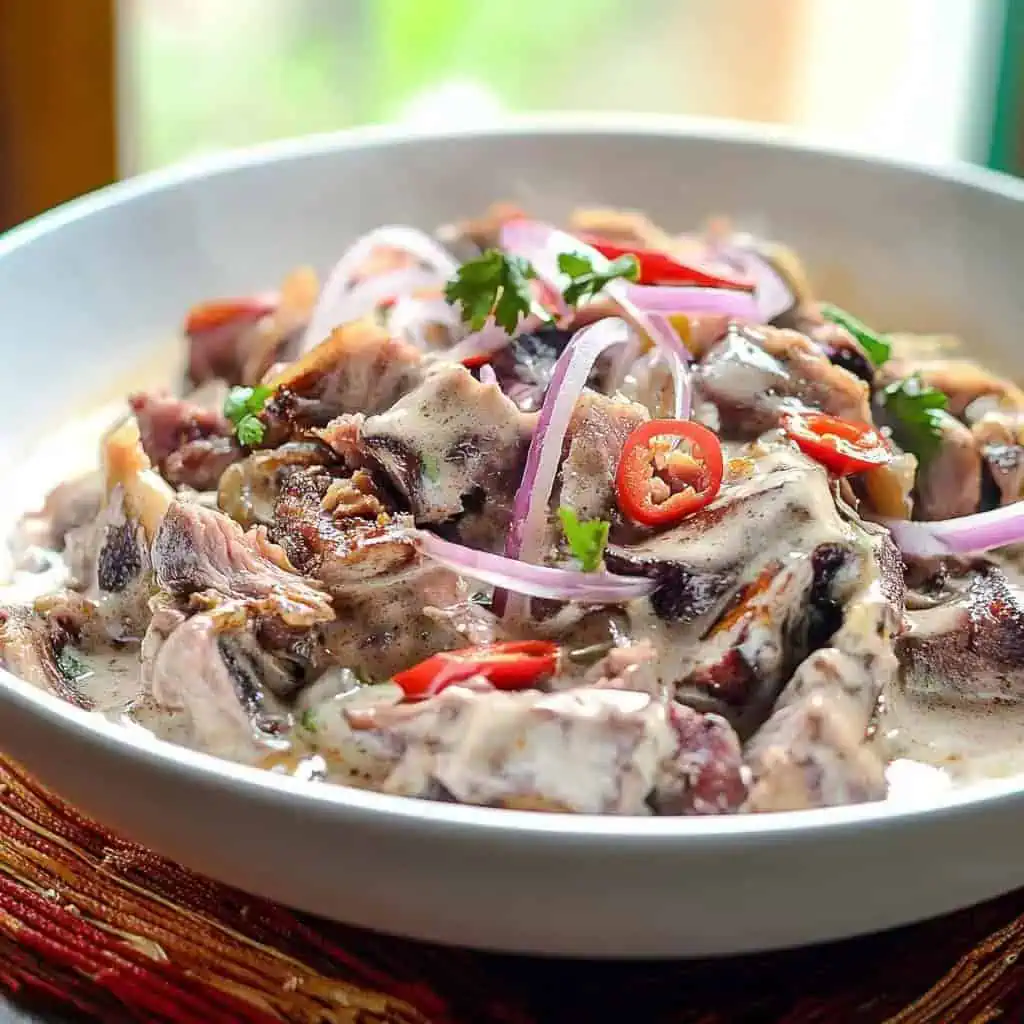
How To Make
- In a large pot over medium heat (160°C/320°F), combine 2 pounds pork face/snout and ears, 2 tablespoons salt, 1 teaspoon whole peppercorns, 2 bay leaves, and enough water to cover the meat.
- Bring to a boil over high heat (200°C/400°F), then reduce to medium-low heat (140°C/285°F). Simmer for 45-60 minutes until the meat is tender but still firm.
- Add ½ pound pork liver to the same pot and cook for 3-5 minutes until half-done. In a separate pot, cook 8 ounces pig brain for 8-10 minutes. Once cooked, mash the brain until smooth and set aside.
- Preheat your grill to medium-high heat (350-400°F/175-200°C). Grill the boiled pork parts for 4-6 minutes per side until crispy and charred. Grill the liver for 3-5 minutes until fully cooked.
- Let the grilled meat rest for 5 minutes, then chop everything into small, bite-sized pieces. In a large bowl, combine the chopped meat with thinly sliced red onion, minced ginger, and minced Thai chili peppers.
- Add ¼ cup calamansi juice and toss everything together. Gently fold in the mashed brain until well distributed. Season with salt and pepper to taste. Let rest for 2-3 minutes before serving to allow flavors to meld together.
- Serve immediately while still warm, ideally with ice-cold beer or steaming white rice. For best results, maintain consistent temperatures throughout cooking to ensure tender meat and optimal texture.

Tips from Lola's Kitchen
- Boiling Enhancement: Add 2-3 stalks of lemongrass to the boiling liquid for deeper aromatics that complement the pork's richness.
- Texture Mastery: Score the pork ears in a crosshatch pattern before grilling to allow better flavor absorption and create more textural contrast.
- Heat Control: Keep Thai chilies whole during mixing if you want milder heat, then remove before serving. For extra heat, finely mince and include the seeds.
- Resting Period: Always allow meats to rest before chopping - this preserves juices and makes for more succulent final results.
- Brain Preparation: When mashing brain, add a teaspoon of calamansi juice to prevent discoloration and enhance creaminess.
- Chopping Technique: Use a rocking motion with your knife when chopping the meat for more consistent pieces and to preserve juiciness.
- Aromatics Timing: Add half the onions during mixing and reserve half as garnish for serving to create layers of flavor - some cooked and mellow, some fresh and sharp.
- Temperature Control: Never boil the brain; gentle simmering prevents it from becoming grainy and ensures a silky-smooth sauce.
Substitutions
- Brain Alternative: Replace pig brain with ½ cup mayonnaise mixed with 1 tablespoon of sour cream for comparable creaminess.
- Citrus Options: No calamansi? Use 3 tablespoons lemon juice mixed with 1 tablespoon of orange juice to replicate calamansi's unique sweet-sour profile.
- Onion Varieties: White or yellow onions can replace red onions, though they lack the color contrast. Add a pinch of sugar to mimic red onion's sweetness.
- Heat Adjustments: Substitute Thai chilies with jalapeños or serrano peppers for milder heat while maintaining flavor complexity.
- Meat Options: If pork face/snout is unavailable, use pork belly (1½ pounds) plus ½ pound pork shoulder for textural variety.
- Herb Substitutions: Out of bay leaves? Use 1 teaspoon dried oregano or ½ teaspoon dried thyme in the boiling liquid.
- Liver Alternative: Chicken livers can replace pork liver in equal amounts but reduce cooking time to 2-3 minutes.
- Alcohol-Free Version: If serving to non-drinkers, add 1 tablespoon apple cider vinegar to enhance flavors typically complemented by beer.
Troubleshooting
- Too Dry: If your dinakdakan seems dry, gently fold in 1-2 tablespoons of the reserved boiling liquid or additional brain mixture/mayonnaise until desired consistency is reached.
- Too Salty: Balance excessive saltiness with an additional tablespoon of calamansi juice and a teaspoon of sugar to create harmony.
- Too Spicy: Cool excessive heat by adding more onions and a tablespoon of mayonnaise or yogurt to mellow the chilies' punch.
- Tough Meat: If meat remains tough after grilling, chop it more finely and return to a covered bowl with a tablespoon of warm boiling liquid for 5 minutes before mixing with other ingredients.
- Not Crispy Enough: Ensure your grill reaches proper temperature before adding meat. If still not crispy, quickly place under a broiler for 1-2 minutes before chopping.
- Bitter Liver: If liver tastes bitter, soak it in milk for 30 minutes before cooking, then rinse thoroughly and pat dry.
- Runny Sauce: If the mixture is too watery, add a tablespoon of crushed chicharrón (pork cracklings) to absorb excess moisture.
- Lacking Flavor: Enhance bland dinakdakan by adding ½ teaspoon fish sauce and an extra minced garlic clove to intensify umami notes.
Storage & Reheating
- Refrigeration: Store leftovers in an airtight container with a piece of paper towel on top to absorb excess moisture. Refrigerate for up to 3 days.
- Optimal Consumption: For best texture and flavor, consume within 24 hours of preparation.
- Reheating Method: Warm in a non-stick pan over medium heat until just hot (about 3-4 minutes), stirring occasionally to prevent sticking or burning.
- Flavor Refresh: Add a teaspoon of fresh calamansi juice and a sprinkle of sliced green onions after reheating to brighten flavors.
- Preventing Dryness: When reheating, add a teaspoon of water or chicken broth to maintain moisture.
- Room Temperature Option: For the best flavor profile, allow refrigerated dinakdakan to sit at room temperature for 15 minutes before reheating.
- Microwave Alternative: If using a microwave to reheat, cover with a damp paper towel and heat at 70% power in 30-second intervals, stirring between each interval.
- Do Not Freeze: Freezing significantly damages the texture of both the meat and the sauce, making it unpleasantly grainy upon thawing.
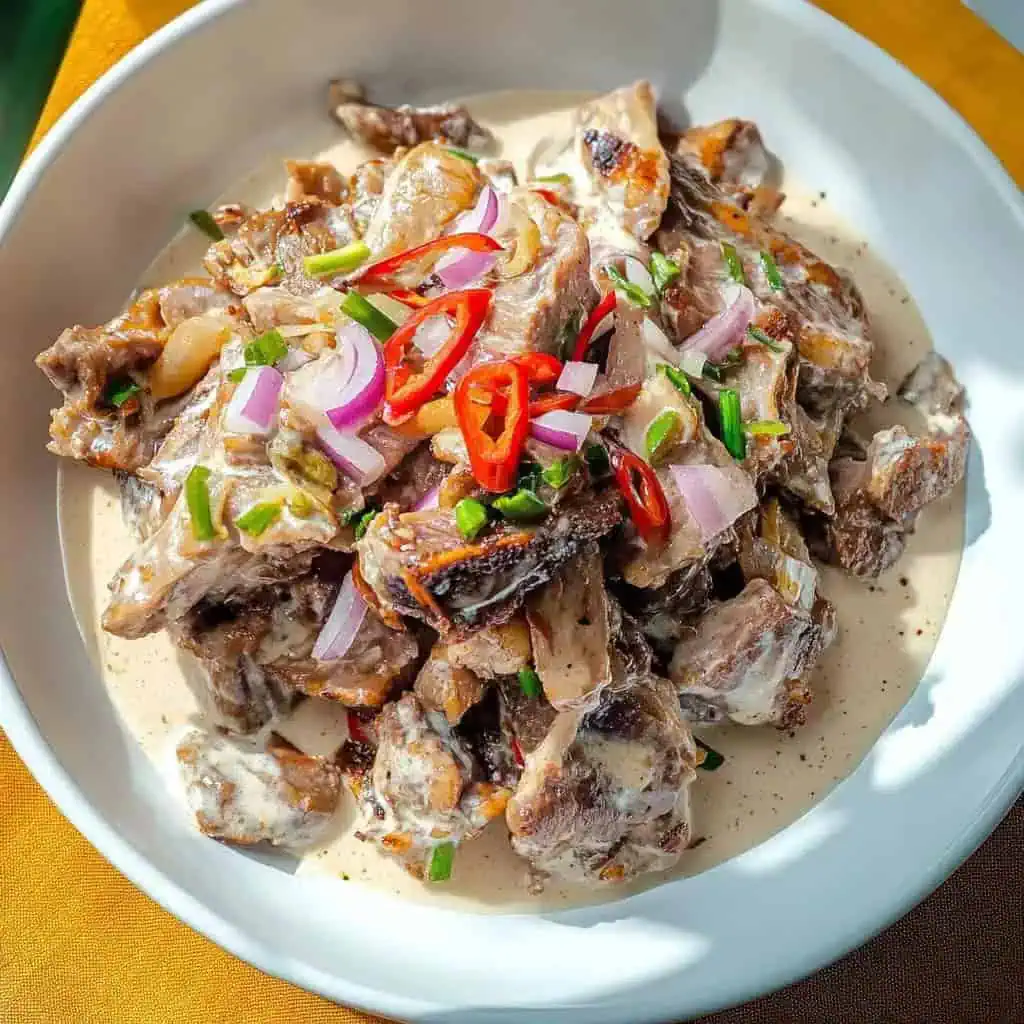
FAQ
Can I make dinakdakan ahead of time?
Yes, you can prepare all components up to 24 hours ahead. Keep the grilled chopped meat, aromatics, and brain/mayo mixture separate in the refrigerator. Combine and add calamansi juice just before serving for optimal freshness and texture.
How do I know when the meat is tender enough during boiling?
The meat should be fork-tender but still hold its shape. Insert a fork into the thickest part – it should enter with moderate resistance but not fall apart. Typically, this takes 45-60 minutes depending on the thickness of the cuts.
Is there a non-spicy version I can make for children or those sensitive to heat?
Absolutely! Omit the Thai chilies completely and use bell peppers for color and crunch instead. Add a pinch of black pepper for subtle warmth without heat. The dish's flavor profile remains delicious even without the spicy component.
How long can I store leftovers safely?
While technically safe for up to 3 days in the refrigerator, the quality deteriorates significantly after 24 hours. The texture of the meat changes and the sauce can separate, so it's best enjoyed fresh or within one day of preparation.
Can I use an indoor grill or broiler instead of a charcoal grill?
Yes, though you'll sacrifice some of the authentic smoky flavor. If using an indoor grill pan or broiler, heat to high (400°F/200°C) and consider adding a few drops of liquid smoke to the meat before grilling to mimic the traditional charcoal-grilled taste.
How can I make this dish more accessible with commonly available ingredients?
Use pork belly instead of face/ears, substitute mayonnaise for brain, use lemon juice instead of calamansi, and replace Thai chilies with jalapeños. While not traditional, this version captures the essence of dinakdakan with supermarket ingredients.
Is dinakdakan safe to eat during pregnancy?
Pregnant women should avoid traditional dinakdakan with undercooked pig brain due to food safety concerns. Instead, make a version using fully cooked meat and mayonnaise as the creamy element, ensuring all pork reaches 145°F (63°C) internal temperature with a 3-minute rest time.
What's the best drink pairing for authentic dinakdakan?
Traditionally, it's served with ice-cold beer, particularly San Miguel or Red Horse for authentic Filipino pairing. Non-alcoholic alternatives include calamansi juice with soda water or coconut water, which complement the rich, tangy flavors.
Related
Looking for other recipes like this? Try these:
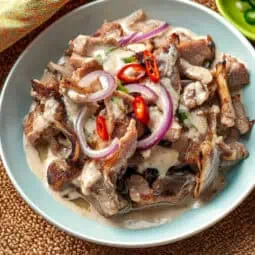
Authentic Ilocano Dinakdakan (Warek-Warek)
Equipment
- Large pot (kaldero) for simmering pork parts
- Charcoal grill (ihawan) for achieving that essential smoky flavor
- Cutting board (sangkalan) and sharp knife (kutsilyo) for chopping ingredients
- Mortar and pestle (dikdikan) for mashing the brain or alternatives
- Metal tongs (sipit) for handling meat while grilling
- Mixing bowl (mangkok) for combining ingredients
- Colander (salaan) for draining cooked meat
Ingredients
For the Meat Base
- 2 pounds pork face/snout ears (maskara at tainga ng baboy)
- ½ pound pork liver atay ng baboy
- 8 ounces pig brain utak ng baboy
- Water for boiling
For the Aromatics
- 2 bay leaves dahon ng laurel
- 2 tablespoons salt asin
- 1 teaspoon whole peppercorns pamintang buo
- 1 red onion thinly sliced (sibuyas)
- 1 thumb-sized ginger minced (luya)
- 3 Thai chili peppers minced (siling labuyo)
For the Dressing
- ¼ cup calamansi juice katas ng kalamansi
- Salt and pepper to taste asin at paminta
Instructions
- In a large pot over medium heat (katamtamang init, 160°C/320°F), combine 2 pounds pork face/snout and ears, 2 tablespoons salt (asin), 1 teaspoon whole peppercorns (pamintang buo), 2 bay leaves (dahon ng laurel), and enough water to cover the meat.
- Bring to a boil over high heat (malakas na apoy, 200°C/400°F), then reduce to medium-low heat (mahina hanggang katamtamang apoy, 140°C/285°F). Simmer for 45-60 minutes until the meat is tender but still firm.
- Add ½ pound pork liver (atay ng baboy) to the same pot and cook for 3-5 minutes until half-done. In a separate pot, cook 8 ounces pig brain (utak ng baboy) for 8-10 minutes. Once cooked, mash the brain until smooth and set aside.
- Preheat your grill to medium-high heat (350-400°F/175-200°C). Grill the boiled pork parts for 4-6 minutes per side until crispy and charred. Grill the liver for 3-5 minutes until fully cooked.
- Let the grilled meat rest for 5 minutes, then chop everything into small, bite-sized pieces. In a large bowl, combine the chopped meat with thinly sliced red onion (sibuyas), minced ginger (luya), and minced Thai chili peppers (siling labuyo).
- Add ¼ cup calamansi juice and toss everything together. Gently fold in the mashed brain until well distributed. Season with salt and pepper (asin at paminta) to taste. Let rest for 2-3 minutes before serving to allow flavors to meld together.
- Serve immediately while still warm, ideally with ice-cold beer or steaming white rice (kanin). For best results, maintain consistent temperatures throughout cooking to ensure tender meat and optimal texture.
Tips from Lola's Kitchen
- Boil pork parts with lemongrass (tanglad) for extra aromatics
- Score the pork ears before grilling for better flavor absorption
- Control the heat level by adjusting the amount of chilies
- Let the meat rest for 5 minutes before chopping for juicier results
- Always taste before adding more salt, as the boiling liquid already contains salt
Nutrition
The Story Behind Dinakdakan (Warek-Warek)
Long before Dinakdakan became a staple in Filipino bars and restaurants across the country, it emerged from the resourceful kitchens of Ilocos, where the tradition of nose-to-tail cooking has been practiced for generations. This iconic dish, also known as "warek-warek" in Ilocano dialect, showcases the region's commitment to minimizing food waste while creating extraordinary flavors.
The name "Dinakdakan" comes from the Ilocano word "dakdak," which means "to chop," referring to the preparation method where grilled pork parts are chopped into small, bite-sized pieces. This technique was traditionally used by Ilocano households to make tougher cuts of meat more palatable and to ensure every precious portion of the animal was utilized.
What sets Dinakdakan apart from other Filipino grilled meat dishes is its distinctive creamy sauce, traditionally made from cooked pig brain. This ingenious addition was born from the Ilocano philosophy of "zero waste" cooking, transforming what might otherwise be discarded into an essential component that gives the dish its signature richness. The combination of charred meat, creamy sauce, tangy calamansi, and spicy chilies creates a flavor profile that's uniquely Ilocano.
Originally served as pulutan (bar food) in small carinderias and drinking spots across Ilocos, Dinakdakan has evolved from its humble beginnings to become a celebrated dish throughout the Philippines. Today, you'll find variations of this dish in Filipino restaurants worldwide, though many still seek out the authentic version made the traditional Ilocano way. Modern interpretations might substitute mayonnaise for pig brain, but the essence of the dish - its smoky, tangy, creamy, and spicy elements - remains true to its origins.
Whether enjoyed as an appetizer with ice-cold beer or served as a main dish with steaming rice, Dinakdakan stands as a testament to Ilocano culinary ingenuity and the enduring appeal of traditional Filipino cooking methods. This dish not only preserves a piece of Filipino food history but continues to captivate new generations of food lovers with its bold flavors and unique preparation.










Comments
No Comments